1 August 2025
Weekly Market View
Taking advantage of the USD rebound
The USD has rebounded from oversold levels on the back of US trade deals, resilient economic and corporate earnings data and a relatively hawkish Fed. We flagged a potential USD short squeeze in our H2 outlook in June.
We would now use the USD rebound to reduce any excessive exposure to US assets and rotate to relatively inexpensive Asia ex-Japan stocks and EM local currency bonds.
In Asia ex-Japan, we are overweight on China and South Korea equities. The region should benefit from easing trade uncertainty and supportive domestic policies.
In bonds, we prefer shorter maturities, given the risk of a delay in Fed rate cuts. We are bullish on short-duration US high yield corporate bonds.
Upcoming US job market data, including July’s payrolls due tonight, will be closely watched. It will take a decisively weaker job market in the next couple of months for the Fed to cut rates in September.
Rotate to China, South Korea equities: Domestic policy support, US trade truce/deals
Maintain 5-7-year maturity on USD bonds: Treasury issuance to cause volatility in long-term bonds
Rangebound USD/JPY: Fed and BoJ both taking a cautious approach to monetary policy
Charts of the week: USD breaking higher?
The dollar has broken above its 100DMA resistance, helped by trade deals, a hawkish Fed and strong corporate earnings
US dollar index (DXY) and 50-, 100- and 200-DMA resistance
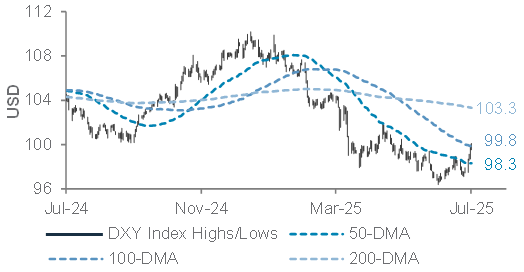
Consensus MSCI US index earnings growth estimates
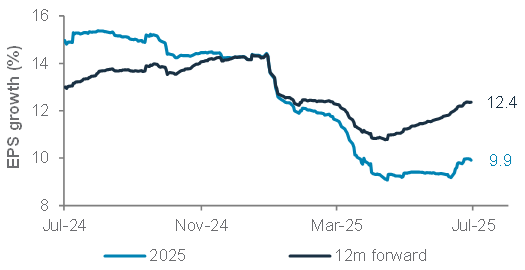
Source: Bloomberg, Standard Chartered
Editorial
Taking advantage of the USD rebound
Investment Strategy: The USD has rebounded from oversold levels on the back of US trade deals, resilient economic and corporate earnings data and a relatively hawkish Fed. We flagged a potential USD short squeeze in our H2 outlook in June. We would now use the USD rebound to reduce any excessive exposure to US assets and rotate to relatively inexpensive Asia ex-Japan stocks and EM local currency bonds. In Asia ex-Japan, we are overweight on China and South Korea equities. The region should benefit from easing trade uncertainty and supportive domestic policies. In bonds, we prefer shorter maturities, given the risk of a delay in Fed rate cuts as inflation rises in the short term due to the tariffs. We are bullish on short-duration US high yield corporate bonds.
Trade deals to ease uncertainty. The US has reached tentative agreements with major trade partners, with the main exception of China and India, with new tariffs implemented from 7 August. Partners with sizable trade surplus vs. the US such as the European Union, Japan and South Korea will face a 15% baseline tariff, while most of southeast Asia faces 19-20% tariff and Canada’s exports not covered under USMCA face 35%. Meanwhile, the US has extended a truce with Mexico for 90 days, with a similar extension vs. China likely to follow. While legalising these agreements will likely take months, if not years, they reduce a major uncertainty clouding global markets.
Tariffs to raise near-term US inflation. A 15% baseline tariff against key allies is higher than the previously anticipated 10% base rate. The Yale Budget Lab estimated that the tariffs, after accounting for consumption shifts, will raise the average US tariff rate to 17.5% (highest since 1934), raise short-run consumer prices by 1.8% and cut US real GDP growth by 0.5% each in 2025 and 2026. This puts the Fed in a dilemma.
Rising chance of delayed Fed rate cuts. This week, Fed Chair Powell, after holding rates for the fifth straight meeting, declined to commit to a rate cut in September, citing inflation
uncertainty. Two of the 11 Fed policymakers voted for rate cuts, the first such double-dissent in over three decades. The Fed will have two monthly inflation and employment reports before its September decision. It will likely take a decisive slowdown in the job market in the next two months for the Fed to restart rate cuts in September. Money markets are pricing just over 40% chance of a September cut, down from 90% at the start of July.
Trade deals, hawkish Fed lifts USD, creating opportunities. The USD index (DXY) has broken above the 100DMA resistance around 100 following a short squeeze from oversold levels. This was aided by US trade deals with key partners without any retaliation, robust economic and corporate earnings reports (see pages 3 and 6) and prospect of delayed Fed rate cuts. Strong momentum could drive DXY 2% higher towards May’s high of 102. However, easing trade uncertainty, robust earnings and bullish long-term quant models suggest using the ongoing USD rebound to average into equities, especially into relatively inexpensive ex-US markets.
Rotating to Asia ex-Japan equities and EM local bonds. The US trade agreements with EU and key Asian partners and some tariff exemptions for Brazil reduces a major uncertainty for Emerging Markets reliant on global trade. In Asia ex-Japan, we are overweight on China and South Korea equities. China’s earnings outlook is likely to improve as authorities tackle overcapacity and excessive price competition. We particularly like China’s technology sector, which is backed by state policy. South Korea’s efforts to boost shareholder returns, combined with a US trade deal that puts tariff on par with that vs. Japan, is positive for the equity market over a 6-12-month horizon.
Prefer shorter maturity USD bonds. US tariffs are likely to revive short-term inflation, potentially delaying Fed rate cuts. Focussing on relatively shorter maturities in bonds is important in this environment. We prefer the 5-7-year maturity bucket in USD bonds. We would also add to short-duration US high yield corporate bonds, which are backed by resilient corporate fundamentals and are less sensitive to US rate moves.
The weekly macro balance sheet
Our weekly net assessment: On balance, we see the past week’s data and policy as neutral for risk assets in the near-term
(+) factors: Improving US growth, consumer confidence; easing trade tensions between US, EU and China
(-) factors: Falling US job openings, rising US inflation pressures, elevated US-India tensions, Fed’s hawkish-tilt
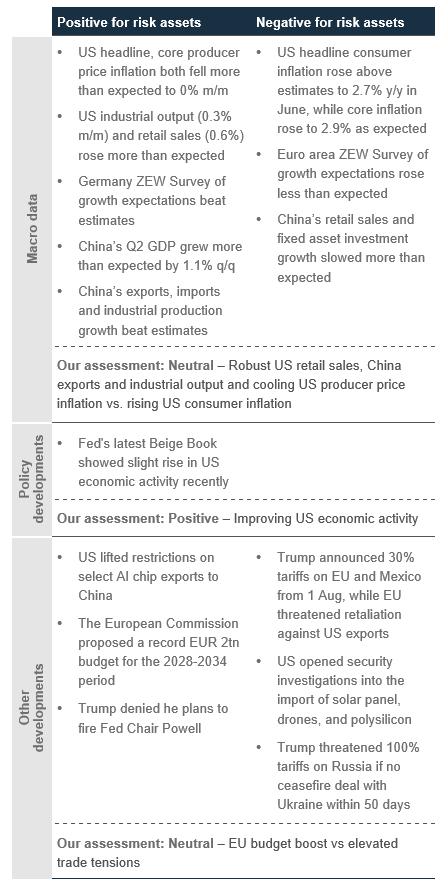
US consumer confidence improved in July, beating expectations, while US goods trade deficit narrowed unexpectedly in June
US Conference Board consumer confidence and goods trade deficit
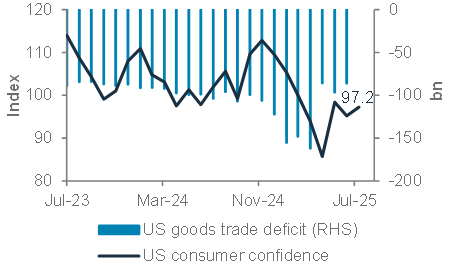
German IFO business expectations improved to the highest level since April 2023, but remained below estimates
German IFO business expectations
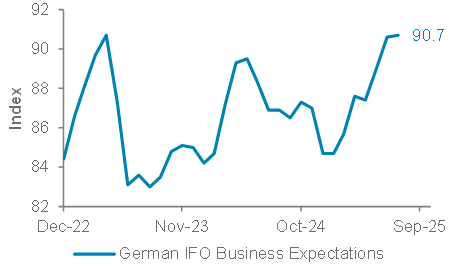
China’s manufacturing and non-manufacturing PMIs both fell more than expected in July
China official manufacturing and non-manufacturing PMI
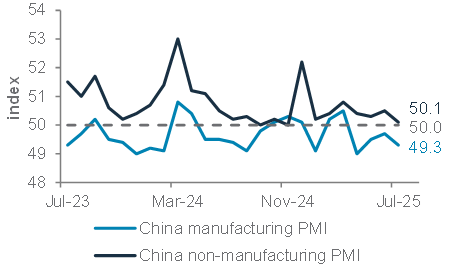
Top client questions
What are the market implications of recent US trade deals?
Our view: The latest agreements are like to reduce trade uncertainty. We prefer Asia-ex-Japan region within a globally diversified equity allocation, particularly South Korea and China markets. We are also bullish Europe’s industrial sector.
Rationale: The US trade deals with most large trade partners, secured ahead of President Trump’s 1 August deadline (12 Aug for talks with China), are positive for the US in protecting domestic businesses.
The US-EU trade deal provides incremental support to European markets as the tariff rate is not as high as feared. However, markets have already priced this in – equities have been flat since the two sides reached an agreement on 27 July. The focus now moves to the US’s investigations on Section 232, which may result in an extended levy on European exports to the US. This could be a headwind for European equities, because the US accounted for 21% of EU’s exports in 2024. Moreover, tariffs and geopolitical tensions have weakened Europe’s earnings guidance. EPS growth projection for Q2 25 is muted at 1.8% y/y (source: LSEG I/B/E/S), with 37% of STOXX 600 companies having reported as of 29 July.
That said, Europe’s industrial sector is the bright spot within the region, supporting our opportunistic idea. The consensus expects 4.5% earnings growth in Q2 25, fourth highest across all the sectors in the index. More importantly, the sector is a beneficiary from rising defence spending and the US-EU trade deal, because of the “zero-for-zero” tariff policy i.e. the elimination of tariffs by both the US and the EU across strategic products, including aircrafts and aircraft parts.
In our globally diversified allocation, we continue to favour Asia ex-Japan equities. We are Overweight South Korea within the region. The trade agreement earlier this week lifts a major uncertainty. We continue to expect supportive measures from the government to boost shareholder returns and further fiscal stimulus, supporting a sustained valuation re-rating of South Korean equities.
We are also Overweight China equities within Asia ex-Japan. Slowing macro data and lack of policy stimulus at the latest Politburo meeting has led to consolidation. That said, such consolidations are opportunities to add exposure as the government steps up efforts to end price wars and tackle excessive capacity. There is still potential for fiscal measures ahead of a series of official meetings in the coming months, e.g. Beidaihe meeting in early-August.
— Michelle Kam, CFA, Investment Strategist
Europe’s industrial sector is likely to see healthy EPS growth, with tailwind from “zero-for-zero” tariff policy
Consensus Q2 25 earnings projections for sectors in Europe’s STOXX600 index
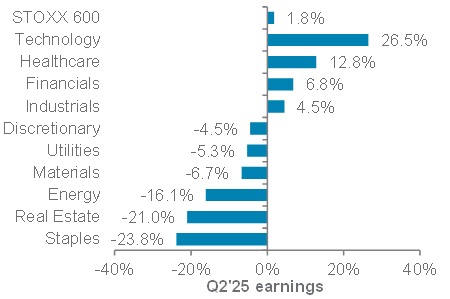
Supportive measures from the Korean government will likely fuel a sustained valuation rerating of South Korean stocks
Relative valuation for MSCI Korea index vs MSCI Asia ex-Japan index
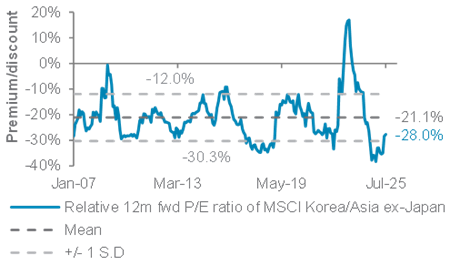
Top client questions (cont’d)
The US Treasury plans to borrow over USD 1tn in Q3, significantly above the amount announced in April. How would this impact the US long term bond yield?
Our view: We believe interest rate volatility will persist. We will add to bonds if the US 10-year government bond yield spikes above 4.5%. Our preferred bond tenor remains 5-7 years.
Rationale: The significant increase in planned debt issuance raises concerns about long-term fiscal sustainability. Yet, there has been limited impact on US government bond yields, with the 10-year government bond yield showing little movement following recent announcements. Treasury Secretary Scott Bessent has indicated that the US Treasury aims to avoid large increases in long-term debt issuance to manage borrowing costs amid rising long-term yields. Despite an expected increase in the supply of shorter-term bonds, market sentiment and demand remain strong. For instance, the US Treasury conducted a USD 44bn auction on Tuesday, where the 7-year government bond auction saw a bid/cover ratio of 2.8x, the highest since November 2012, reflecting robust demand.
Currently, the average maturity of US government bonds stands at 72 months, down from a peak of 75 months in May 2023, yet significantly higher than the low of 49 months during the global financial crisis. Historically, the US government has increased short-term debt during crises, and Bessent’s strategy of issuing short-term government bonds for flexibility, while maintaining market stability, is not unprecedented.
While the 10-year bond yield could rise to 4.5-4.6% due to market concerns about trade, inflation, and the government’s fiscal position, we believe this would present an opportunity to lock in yields. Our preferred tenor of 5-7 years offers the best risk-adjusted returns, balancing attractive yields with fiscal and inflation risks. Investors wary of interest rate volatility could consider our opportunistic bullish idea: short duration US HY bonds. The short duration HY bonds are less sensitive to interest rate volatility and exhibit lower price volatility and drawdowns compared to both US HY and investment grade corporate bonds, thereby offering the prospect of better risk-adjusted returns.
— Ray Heung, Senior Investment Strategist
The current average maturity of US government bonds is high compared to history. The US Treasury has the flexibility to use shorter tenor debt to lower interest cost
Average maturity of US government bonds
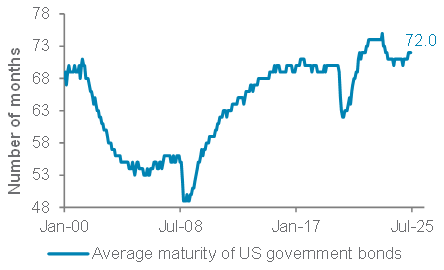
Top client questions (cont’d)
How have US Q2 earnings fared? Are there any insights into the upcoming semiconductor sector earnings?
Our view: Strong US earnings support our constructive view on equities. This has positive implications for the semiconductor industry earnings. Add to US technology sector on pullbacks – technical indicators are stretched in the short-term.
Rationale: The US Q2 earnings have been positive at the half-way mark of the earnings season. All sectors have delivered a positive surprise except for real estate. Consensus 2025 earnings growth for the S&P500 has been revised up to 9.3%, versus 8.5% at the start of the reporting season, especially in our preferred sectors of technology, communication and financials. This upward revision is a function of Q2 earnings beating expectations and strong guidance. 2026 earnings growth estimate also remains stable at 14.0%.
Major internet and technology companies continue to invest significantly into AI infrastructure and capabilities, raising their capex guidance. This has positive implications for the semiconductor industry and other companies involved in the AI infrastructure supply chain. We remain positive on the broad technology sector over 6-12 months. Add to the US technology sector on pullbacks.
— Fook Hien Yap, Senior Investment Strategist
Consensus 2025 earnings growth has been revised higher for US equities, including for our preferred technology, communication and financial sectors
Consensus 2025 earnings growth estimates for S&P500 sectors as of 31 July vs. 1 July
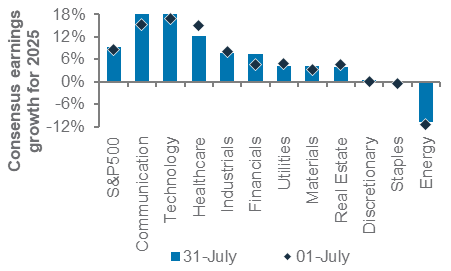
What is the USDJPY outlook after the latest Fed and BoJ meetings?
Our View: The Fed and BoJ are both taking a cautious approach on monetary policy. Play the range in USD/JPY between 147 and 152.
Rationale: The USD index (DXY) is testing 100-day moving average (MA) and is close to our 3-month target. The Fed held rates and pared back rate cut expectations for September, while Q2 GDP growth surprised to the upside and US core PCE inflation accelerated to 0.3% m/m. We expect the USD to be well supported for now, with next resistance at 102. Further rally will depend upon the final trade settlements with other major economies (like China, Mexico, Canada and India), more clarity on the investment pledges made by the EU, Japan and South Korea.
Despite the recent tariff deal between the US and Japan, the BoJ continues to be cautious and held rates at 0.5%. The bank also raised FY2025 core consumer inflation forecasts from 2.2% to 2.7% but noted economic risks are on the downside for FY 2025 and 2026. This strengthened the yen briefly, but this is likely to balance out with the firmer greenback in the coming weeks. We see USD/JPY rangebound between 147-152 in the near term.
— Iris Yuen, Investment Strategist
USD/JPY to remain rangebound in the near-term
USD/JPY and technical levels
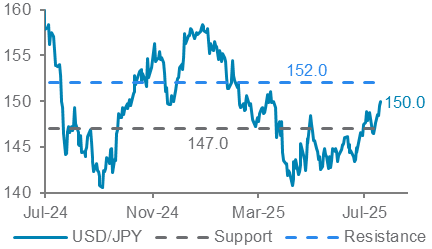
Top client questions (cont’d)
Do you expect the silver rally to continue?
Our View: The risk/reward in silver prices is now less compelling. A more attractive entry point could emerge if prices correct to the 100-day moving average near USD 34/oz
Rationale: Silver has finally outpaced gold after years of underperformance, with YTD gains at 29% versus gold’s 25%. This surge is due to a tight physical market, attractive relative valuations, an ongoing recovery in global industrial production, and, to a lesser extent, heightened US policy uncertainty, which has revived safe-haven demand.
However, much of the easy upside may now be behind us. The gold/silver ratio, which spiked above 100 in April for only the third time since the 1970s, offered investors a rare and historically profitable entry point. At such extremes, silver has delivered positive returns with near-perfect consistency. However, with the ratio now down to 88, closer to its 10-year average of 81, silver’s relative value appeal has diminished, and the risk-reward profile, particularly in the near-term, is not compelling. We expect Gold to remain rangebound near USD 3,400/oz, barring a clear deterioration in US growth, which also limits further upside potential for silver.
Silver’s longer-term outlook is more mixed. Physical demand has outstripped supply for five consecutive years and industry forecasts suggest the deficit will persist. With over half of silver’s demand tied to industrial use, a continued global production rebound should offer support. However, there are emerging headwinds. Growth in global photovoltaic installations, a major source of silver demand, is expected to stagnate in 2026 amid shifts in China’s policy. Unlike gold, silver also lacks meaningful central bank demand and is more vulnerable to trade-related growth shocks.
Given its higher volatility and strong beta to the global cycle, silver is better treated as a tactical rather than a strategic asset. A more compelling re-entry point could emerge if prices correct to the 100-day moving average near USD 34/oz, where the gold/silver ratio may again approach 100, should gold remains rangebound near USD 3,400/oz, restoring a more asymmetric setup for upside exposure.
— Tay Qi Xiu, Portfolio Strategist
The gold/silver ratio spiked above 100 in April for the third time since the 1970s
Gold/silver ratio and the 10-year moving average
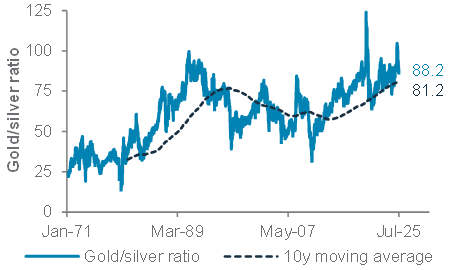
At the current gold/silver ratio, the risk/reward in the near-term for silver is not compelling
Period-ahead min/max/average returns when gold/silver ratio is between 85 and 90
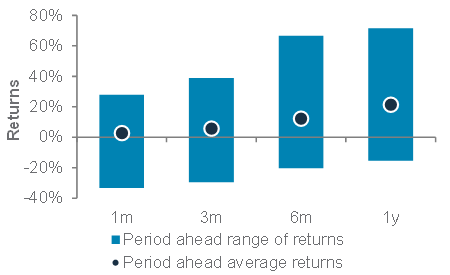
Silver demand is linked to global production
World industrial production and silver industrial demand
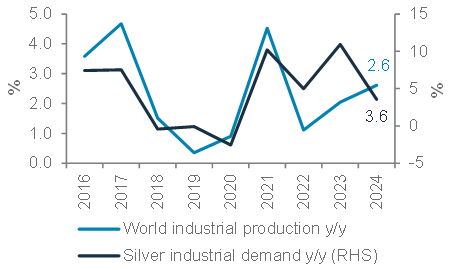
Top client questions (cont’d)
What are the potential implications of the US GENIUS Act?
Our View: The US GENIUS Act should support demand for US government debt (T-bills) demand, the USD and digital assets.
Rationale: The signing of the Guaranteeing Essential National Infrastructure in US-Stablecoins (GENIUS) Act marks the first comprehensive U.S. framework for stablecoins, aiming to bring oversight, security and confidence to the rapidly expanding cryptocurrency market. The law limits issuance to regulated financial institutions, mandates full 1:1 reserves backed by US government bills or other low-risk assets with a maturity of 93 days or less, and enforces strict anti-money laundering and counter-terrorism measures, placing the U.S. alongside global peers such as the EU’s MiCA regime and Hong Kong’s Stablecoin Ordinance.
This has positive implications for US government debt (T-bills) demand, the USD and digital assets.
With around USD 260.7bn of stablecoins in circulation, according to Artemis, this legislation is expected to further legitimise the industry, fueling broader adoption across both retail and traditional finance. As usage expands, stablecoin issuers’ demand for US T-bills could surge on the back of reserve demand from stablecoin issuers and offer some support to the USD as global adoption of dollar-backed stablecoins accelerates.
However, the act also introduces new risks. In periods of market stress, selling pressure on stablecoins could result in knock-on selling pressure on US debt reserves, temporarily disrupting supply-demand dynamics in T-bill markets, with potential knock-on effects on asset prices and liquidity conditions.
— Anthony Naab, CFA, Investment Strategist
The US GENIUS Act should help boost demand for US Treasury bills, the USD and digital assets
US 12-month Treasury bill yield
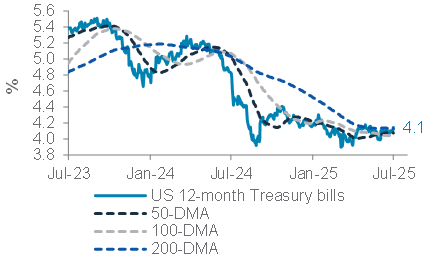
Market performance summary*
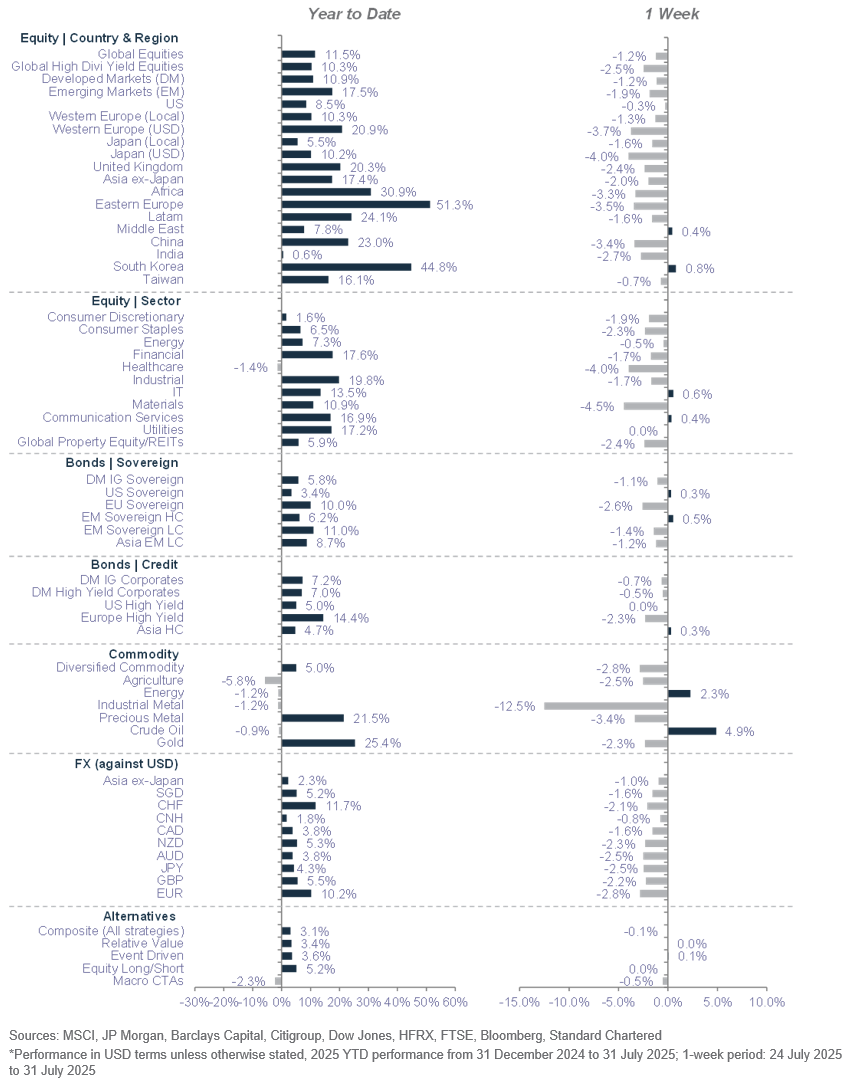
Our 12-month asset class views at a glance
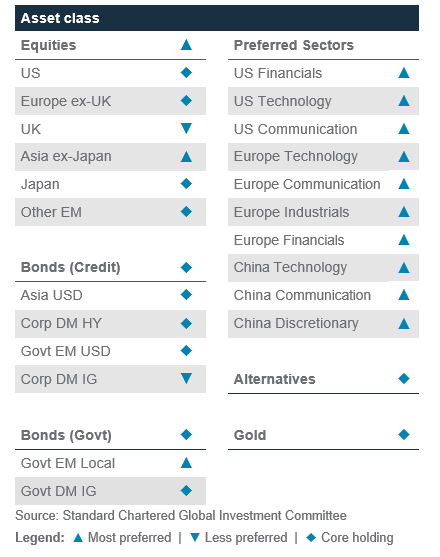
Economic and market calendar
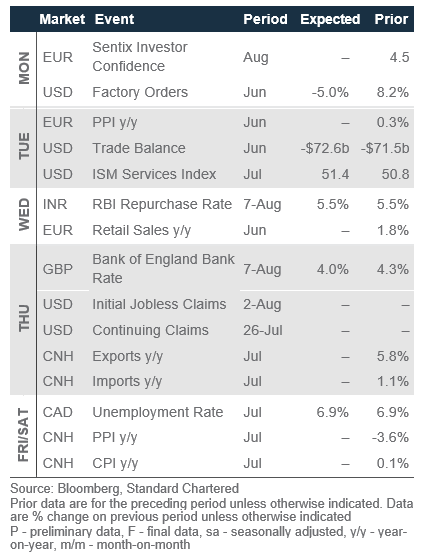
The S&P500 has next interim resistance at 6,452
Technical indicators for key markets as of 31 Jul close
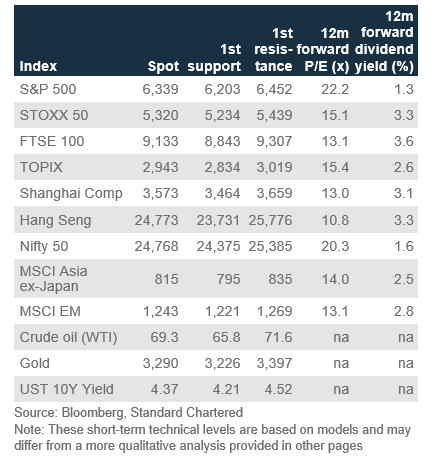
Investor diversity in global equities stays below threshold
Our proprietary market diversity indicators as of 31 Jul close
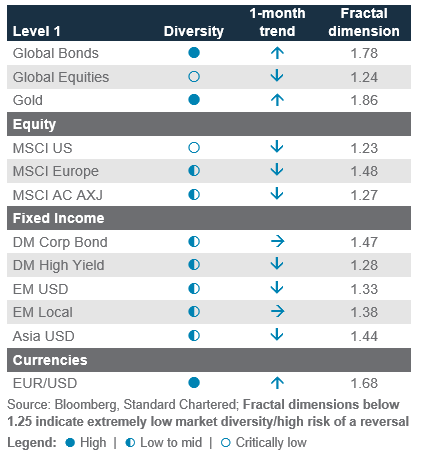

Disclosure
This document is confidential and may also be privileged. If you are not the intended recipient, please destroy all copies and notify the sender immediately. This document is being distributed for general information only and is subject to the relevant disclaimers available at our Standard Chartered website under Regulatory disclosures. It is not and does not constitute research material, independent research, an offer, recommendation or solicitation to enter into any transaction or adopt any hedging, trading or investment strategy, in relation to any securities or other financial instruments. This document is for general evaluation only. It does not take into account the specific investment objectives, financial situation or particular needs of any particular person or class of persons and it has not been prepared for any particular person or class of persons. You should not rely on any contents of this document in making any investment decisions. Before making any investment, you should carefully read the relevant offering documents and seek independent legal, tax and regulatory advice. In particular, we recommend you to seek advice regarding the suitability of the investment product, taking into account your specific investment objectives, financial situation or particular needs, before you make a commitment to purchase the investment product. Opinions, projections and estimates are solely those of SC at the date of this document and subject to change without notice. Past performance is not indicative of future results and no representation or warranty is made regarding future performance. The value of investments, and the income from them, can go down as well as up, and you may not recover the amount of your original investment. You are not certain to make a profit and may lose money. Any forecast contained herein as to likely future movements in rates or prices or likely future events or occurrences constitutes an opinion only and is not indicative of actual future movements in rates or prices or actual future events or occurrences (as the case may be). This document must not be forwarded or otherwise made available to any other person without the express written consent of the Standard Chartered Group (as defined below). Standard Chartered Bank is incorporated in England with limited liability by Royal Charter 1853 Reference Number ZC18. The Principal Office of the Company is situated in England at 1 Basinghall Avenue, London, EC2V 5DD. Standard Chartered Bank is authorised by the Prudential Regulation Authority and regulated by the Financial Conduct Authority and Prudential Regulation Authority. Standard Chartered PLC, the ultimate parent company of Standard Chartered Bank, together with its subsidiaries and affiliates (including each branch or representative office), form the Standard Chartered Group. Standard Chartered Private Bank is the private banking division of Standard Chartered. Private banking activities may be carried out internationally by different legal entities and affiliates within the Standard Chartered Group (each an “SC Group Entity”) according to local regulatory requirements. Not all products and services are provided by all branches, subsidiaries and affiliates within the Standard Chartered Group. Some of the SC Group Entities only act as representatives of Standard Chartered Private Bank and may not be able to offer products and services or offer advice to clients.
Copyright © 2025, Accounting Research & Analytics, LLC d/b/a CFRA (and its affiliates, as applicable). Reproduction of content provided by CFRA in any form is prohibited except with the prior written permission of CFRA. CFRA content is not investment advice and a reference to or observation concerning a security or investment provided in the CFRA SERVICES is not a recommendation to buy, sell or hold such investment or security or make any other investment decisions. The CFRA content contains opinions of CFRA based upon publicly-available information that CFRA believes to be reliable and the opinions are subject to change without notice. This analysis has not been submitted to, nor received approval from, the United States Securities and Exchange Commission or any other regulatory body. While CFRA exercised due care in compiling this analysis, CFRA, ITS THIRD-PARTY SUPPLIERS, AND ALL RELATED ENTITIES SPECIFICALLY DISCLAIM ALL WARRANTIES, EXPRESS OR IMPLIED, INCLUDING, BUT NOT LIMITED TO, ANY WARRANTIES OF MERCHANTABILITY OR FITNESS FOR A PARTICULAR PURPOSE OR USE, to the full extent permitted by law, regarding the accuracy, completeness, or usefulness of this information and assumes no liability with respect to the consequences of relying on this information for investment or other purposes. No content provided by CFRA (including ratings, credit-related analyses and data, valuations, model, software or other application or output therefrom) or any part thereof may be modified, reverse engineered, reproduced or distributed in any form by any means, or stored in a database or retrieval system, without the prior written permission of CFRA, and such content shall not be used for any unlawful or unauthorized purposes. CFRA and any third-party providers, as well as their directors, officers, shareholders, employees or agents do not guarantee the accuracy, completeness, timeliness or availability of such content. In no event shall CFRA, its affiliates, or their third-party suppliers be liable for any direct, indirect, special, or consequential damages, costs, expenses, legal fees, or losses (including lost income or lost profit and opportunity costs) in connection with a subscriber’s, subscriber’s customer’s, or other’s use of CFRA’s content.
Market Abuse Regulation (MAR) Disclaimer
Banking activities may be carried out internationally by different branches, subsidiaries and affiliates within the Standard Chartered Group according to local regulatory requirements. Opinions may contain outright “buy”, “sell”, “hold” or other opinions. The time horizon of this opinion is dependent on prevailing market conditions and there is no planned frequency for updates to the opinion. This opinion is not independent of Standard Chartered Group’s trading strategies or positions. Standard Chartered Group and/or its affiliates or its respective officers, directors, employee benefit programmes or employees, including persons involved in the preparation or issuance of this document may at any time, to the extent permitted by applicable law and/or regulation, be long or short any securities or financial instruments referred to in this document or have material interest in any such securities or related investments. Therefore, it is possible, and you should assume, that Standard Chartered Group has a material interest in one or more of the financial instruments mentioned herein. Please refer to our Standard Chartered website under Regulatory disclosures for more detailed disclosures, including past opinions/ recommendations in the last 12 months and conflict of interests, as well as disclaimers. A covering strategist may have a financial interest in the debt or equity securities of this company/issuer. All covering strategist are licensed to provide investment recommendations under Monetary Authority of Singapore or Hong Kong Monetary Authority. This document must not be forwarded or otherwise made available to any other person without the express written consent of Standard Chartered Group.
Sustainable Investments
Any ESG data used or referred to has been provided by Morningstar, Sustainalytics, MSCI or Bloomberg. Refer to 1) Morningstar website under Sustainable Investing, 2) Sustainalytics website under ESG Risk Ratings, 3) MCSI website under ESG Business Involvement Screening Research and 4) Bloomberg green, social & sustainability bonds guide for more information. The ESG data is as at the date of publication based on data provided, is for informational purpose only and is not warranted to be complete, timely, accurate or suitable for a particular purpose, and it may be subject to change. Sustainable Investments (SI): This refers to funds that have been classified as ‘ESG Intentional Investments – Overall’ by Morningstar. SI funds have explicitly stated in their prospectus and regulatory filings that they either incorporate ESG factors into the investment process or have a thematic focus on the environment, gender diversity, low carbon, renewable energy, water or community development. For equity, it refers to shares/stocks issued by companies with Sustainalytics ESG Risk Rating of Low/Negligible. For bonds, it refers to debt instruments issued by issuers with Sustainalytics ESG Risk Rating of Low/Negligible, and/or those being certified green, social, sustainable bonds by Bloomberg. For structured products, it refers to products that are issued by any issuer who has a Sustainable Finance framework that aligns with Standard Chartered’s Green and Sustainable Product Framework, with underlying assets that are part of the Sustainable Investment universe or separately approved by Standard Chartered’s Sustainable Finance Governance Committee. Sustainalytics ESG risk ratings shown are factual and are not an indicator that the product is classified or marketed as “green”, “sustainable” or similar under any particular classification system or framework.
Country/Market Specific Disclosures
Bahrain: This document is being distributed in Bahrain by Standard Chartered Bank, Bahrain Branch, having its address at P.O. 29, Manama, Kingdom of Bahrain, is a branch of Standard Chartered Bank and is licensed by the Central Bank of Bahrain as a conventional retail bank. Botswana: This document is being distributed in Botswana by, and is attributable to, Standard Chartered Bank Botswana Limited which is a financial institution licensed under the Section 6 of the Banking Act CAP 46.04 and is listed in the Botswana Stock Exchange. Brunei Darussalam: This document is being distributed in Brunei Darussalam by, and is attributable to, Standard Chartered Bank (Brunei Branch) | Registration Number RFC/61 and Standard Chartered Securities (B) Sdn Bhd | Registration Number RC20001003. Standard Chartered Bank is incorporated in England with limited liability by Royal Charter 1853 Reference Number ZC18. Standard Chartered Securities (B) Sdn Bhd is a limited liability company registered with the Registry of Companies with Registration Number RC20001003 and licensed by Brunei Darussalam Central Bank as a Capital Markets Service License Holder with License Number BDCB/R/CMU/S3-CL and it is authorised to conduct Islamic investment business through an Islamic window. China Mainland: This document is being distributed in China by, and is attributable to, Standard Chartered Bank (China) Limited which is mainly regulated by National Financial Regulatory Administration (NFRA), State Administration of Foreign Exchange (SAFE), and People’s Bank of China (PBOC). Hong Kong: In Hong Kong, this document, except for any portion advising on or facilitating any decision on futures contracts trading, is distributed by Standard Chartered Bank (Hong Kong) Limited (“SCBHK”), a subsidiary of Standard Chartered PLC. SCBHK has its registered address at 32/F, Standard Chartered Bank Building, 4-4A Des Voeux Road Central, Hong Kong and is regulated by the Hong Kong Monetary Authority and registered with the Securities and Futures Commission (“SFC”) to carry on Type 1 (dealing in securities), Type 4 (advising on securities), Type 6 (advising on corporate finance) and Type 9 (asset management) regulated activity under the Securities and Futures Ordinance (Cap. 571) (“SFO”) (CE No. AJI614). The contents of this document have not been reviewed by any regulatory authority in Hong Kong and you are advised to exercise caution in relation to any offer set out herein. If you are in doubt about any of the contents of this document, you should obtain independent professional advice. Any product named herein may not be offered or sold in Hong Kong by means of any document at any time other than to “professional investors” as defined in the SFO and any rules made under that ordinance. In addition, this document may not be issued or possessed for the purposes of issue, whether in Hong Kong or elsewhere, and any interests may not be disposed of, to any person unless such person is outside Hong Kong or is a “professional investor” as defined in the SFO and any rules made under that ordinance, or as otherwise may be permitted by that ordinance. In Hong Kong, Standard Chartered Private Bank is the private banking division of SCBHK, a subsidiary of Standard Chartered PLC. Ghana: Standard Chartered Bank Ghana Limited accepts no liability and will not be liable for any loss or damage arising directly or indirectly (including special, incidental or consequential loss or damage) from your use of these documents. Past performance is not indicative of future results and no representation or warranty is made regarding future performance. You should seek advice from a financial adviser on the suitability of an investment for you, taking into account these factors before making a commitment to invest in an investment. To unsubscribe from receiving further updates, please send an email to feedback.ghana@sc.com. Please do not reply to this email. Call our Priority Banking on 0302610750 for any questions or service queries. You are advised not to send any confidential and/or important information to Standard Chartered via e-mail, as Standard Chartered makes no representations or warranties as to the security or accuracy of any information transmitted via e-mail. Standard Chartered shall not be responsible for any loss or damage suffered by you arising from your decision to use e-mail to communicate with the Bank. India: This document is being distributed in India by Standard Chartered in its capacity as a distributor of mutual funds and referrer of any other third party financial products. Standard Chartered does not offer any ‘Investment Advice’ as defined in the Securities and Exchange Board of India (Investment Advisers) Regulations, 2013 or otherwise. Services/products related securities business offered by Standard Charted are not intended for any person, who is a resident of any jurisdiction, the laws of which imposes prohibition on soliciting the securities business in that jurisdiction without going through the registration requirements and/or prohibit the use of any information contained in this document. Indonesia: This document is being distributed in Indonesia by Standard Chartered Bank, Indonesia branch, which is a financial institution licensed and supervised by Otoritas Jasa Keuangan (Financial Service Authority) and Bank Indonesia. Jersey: In Jersey, Standard Chartered Private Bank is the Registered Business Name of the Jersey Branch of Standard Chartered Bank. The Jersey Branch of Standard Chartered Bank is regulated by the Jersey Financial Services Commission. Copies of the latest audited accounts of Standard Chartered Bank are available from its principal place of business in Jersey: PO Box 80, 15 Castle Street, St Helier, Jersey JE4 8PT. Standard Chartered Bank is incorporated in England with limited liability by Royal Charter in 1853 Reference Number ZC 18. The Principal Office of the Company is situated in England at 1 Basinghall Avenue, London, EC2V 5DD. Standard Chartered Bank is authorised by the Prudential Regulation Authority and regulated by the Financial Conduct Authority and Prudential Regulation Authority. The Jersey Branch of Standard Chartered Bank is also an authorised financial services provider under license number 44946 issued by the Financial Sector Conduct Authority of the Republic of South Africa. Jersey is not part of the United Kingdom and all business transacted with Standard Chartered Bank, Jersey Branch and other SC Group Entity outside of the United Kingdom, are not subject to some or any of the investor protection and compensation schemes available under United Kingdom law. Kenya: This document is being distributed in Kenya by and is attributable to Standard Chartered Bank Kenya Limited. Investment Products and Services are distributed by Standard Chartered Investment Services Limited, a wholly owned subsidiary of Standard Chartered Bank Kenya Limited that is licensed by the Capital Markets Authority in Kenya, as a Fund Manager. Standard Chartered Bank Kenya Limited is regulated by the Central Bank of Kenya. Malaysia: This document is being distributed in Malaysia by Standard Chartered Bank Malaysia Berhad (“SCBMB”). Recipients in Malaysia should contact SCBMB in relation to any matters arising from, or in connection with, this document. This document has not been reviewed by the Securities Commission Malaysia. The product lodgement, registration, submission or approval by the Securities Commission of Malaysia does not amount to nor indicate recommendation or endorsement of the product, service or promotional activity. Investment products are not deposits and are not obligations of, not guaranteed by, and not protected by SCBMB or any of the affiliates or subsidiaries, or by Perbadanan Insurans Deposit Malaysia, any government or insurance agency. Investment products are subject to investment risks, including the possible loss of the principal amount invested. SCBMB expressly disclaim any liability and responsibility for any loss arising directly or indirectly (including special, incidental or consequential loss or damage) arising from the financial losses of the Investment Products due to market condition. Nigeria: This document is being distributed in Nigeria by Standard Chartered Bank Nigeria Limited (SCB Nigeria), a bank duly licensed and regulated by the Central Bank of Nigeria. SCB Nigeria accepts no liability for any loss or damage arising directly or indirectly (including special, incidental or consequential loss or damage) from your use of these documents. You should seek advice from a financial adviser on the suitability of an investment for you, taking into account these factors before making a commitment to invest in an investment. To unsubscribe from receiving further updates, please send an email to clientcare.ng@sc.com requesting to be removed from our mailing list. Please do not reply to this email. Call our Priority Banking on 02 012772514 for any questions or service queries. SCB Nigeria shall not be responsible for any loss or damage arising from your decision to send confidential and/or important information to Standard Chartered via e-mail. SCB Nigeria makes no representations or warranties as to the security or accuracy of any information transmitted via e-mail. Pakistan: This document is being distributed in Pakistan by, and attributable to Standard Chartered Bank (Pakistan) Limited having its registered office at PO Box 5556, I.I Chundrigar Road Karachi, which is a banking company registered with State Bank of Pakistan under Banking Companies Ordinance 1962 and is also having licensed issued by Securities & Exchange Commission of Pakistan for Security Advisors. Standard Chartered Bank (Pakistan) Limited acts as a distributor of mutual funds and referrer of other third-party financial products. Singapore: This document is being distributed in Singapore by, and is attributable to, Standard Chartered Bank (Singapore) Limited (Registration No. 201224747C/ GST Group Registration No. MR-8500053-0, “SCBSL”). Recipients in Singapore should contact SCBSL in relation to any matters arising from, or in connection with, this document. SCBSL is an indirect wholly owned subsidiary of Standard Chartered Bank and is licensed to conduct banking business in Singapore under the Singapore Banking Act, 1970. Standard Chartered Private Bank is the private banking division of SCBSL. IN RELATION TO ANY SECURITY OR SECURITIES-BASED DERIVATIVES CONTRACT REFERRED TO IN THIS DOCUMENT, THIS DOCUMENT, TOGETHER WITH THE ISSUER DOCUMENTATION, SHALL BE DEEMED AN INFORMATION MEMORANDUM (AS DEFINED IN SECTION 275 OF THE SECURITIES AND FUTURES ACT, 2001 (“SFA”)). THIS DOCUMENT IS INTENDED FOR DISTRIBUTION TO ACCREDITED INVESTORS, AS DEFINED IN SECTION 4A(1)(a) OF THE SFA, OR ON THE BASIS THAT THE SECURITY OR SECURITIES-BASED DERIVATIVES CONTRACT MAY ONLY BE ACQUIRED AT A CONSIDERATION OF NOT LESS THAN S$200,000 (OR ITS EQUIVALENT IN A FOREIGN CURRENCY) FOR EACH TRANSACTION. Further, in relation to any security or securities-based derivatives contract, neither this document nor the Issuer Documentation has been registered as a prospectus with the Monetary Authority of Singapore under the SFA. Accordingly, this document and any other document or material in connection with the offer or sale, or invitation for subscription or purchase, of the product may not be circulated or distributed, nor may the product be offered or sold, or be made the subject of an invitation for subscription or purchase, whether directly or indirectly, to persons other than a relevant person pursuant to section 275(1) of the SFA, or any person pursuant to section 275(1A) of the SFA, and in accordance with the conditions specified in section 275 of the SFA, or pursuant to, and in accordance with the conditions of, any other applicable provision of the SFA. In relation to any collective investment schemes referred to in this document, this document is for general information purposes only and is not an offering document or prospectus (as defined in the SFA). This document is not, nor is it intended to be (i) an offer or solicitation of an offer to buy or sell any capital markets product; or (ii) an advertisement of an offer or intended offer of any capital markets product. Deposit Insurance Scheme: Singapore dollar deposits of non-bank depositors are insured by the Singapore Deposit Insurance Corporation, for up to S$100,000 in aggregate per depositor per Scheme member by law. Foreign currency deposits, dual currency investments, structured deposits and other investment products are not insured. This advertisement has not been reviewed by the Monetary Authority of Singapore. Taiwan: SC Group Entity or Standard Chartered Bank (Taiwan) Limited (“SCB (Taiwan)”) may be involved in the financial instruments contained herein or other related financial instruments. The author of this document may have discussed the information contained herein with other employees or agents of SC or SCB (Taiwan). The author and the above-mentioned employees of SC or SCB (Taiwan) may have taken related actions in respect of the information involved (including communication with customers of SC or SCB (Taiwan) as to the information contained herein). The opinions contained in this document may change, or differ from the opinions of employees of SC or SCB (Taiwan). SC and SCB (Taiwan) will not provide any notice of any changes to or differences between the above-mentioned opinions. This document may cover companies with which SC or SCB (Taiwan) seeks to do business at times and issuers of financial instruments. Therefore, investors should understand that the information contained herein may serve as specific purposes as a result of conflict of interests of SC or SCB (Taiwan). SC, SCB (Taiwan), the employees (including those who have discussions with the author) or customers of SC or SCB (Taiwan) may have an interest in the products, related financial instruments or related derivative financial products contained herein; invest in those products at various prices and on different market conditions; have different or conflicting interests in those products. The potential impacts include market makers’ related activities, such as dealing, investment, acting as agents, or performing financial or consulting services in relation to any of the products referred to in this document. UAE: DIFC – Standard Chartered Bank is incorporated in England with limited liability by Royal Charter 1853 Reference Number ZC18.The Principal Office of the Company is situated in England at 1 Basinghall Avenue, London, EC2V 5DD. Standard Chartered Bank is authorised by the Prudential Regulation Authority and regulated by the Financial Conduct Authority and Prudential Regulation Authority. Standard Chartered Bank, Dubai International Financial Centre having its offices at Dubai International Financial Centre, Building 1, Gate Precinct, P.O. Box 999, Dubai, UAE is a branch of Standard Chartered Bank and is regulated by the Dubai Financial Services Authority (“DFSA”). This document is intended for use only by Professional Clients and is not directed at Retail Clients as defined by the DFSA Rulebook. In the DIFC we are authorised to provide financial services only to clients who qualify as Professional Clients and Market Counterparties and not to Retail Clients. As a Professional Client you will not be given the higher retail client protection and compensation rights and if you use your right to be classified as a Retail Client we will be unable to provide financial services and products to you as we do not hold the required license to undertake such activities. For Islamic transactions, we are acting under the supervision of our Shariah Supervisory Committee. Relevant information on our Shariah Supervisory Committee is currently available on the Standard Chartered Bank website in the Islamic banking section. For residents of the UAE – Standard Chartered UAE (“SC UAE”) is licensed by the Central Bank of the U.A.E. SC UAE is licensed by Securities and Commodities Authority to practice Promotion Activity. SC UAE does not provide financial analysis or consultation services in or into the UAE within the meaning of UAE Securities and Commodities Authority Decision No. 48/r of 2008 concerning financial consultation and financial analysis. Uganda: Our Investment products and services are distributed by Standard Chartered Bank Uganda Limited, which is licensed by the Capital Markets Authority as an investment adviser. United Kingdom: In the UK, Standard Chartered Bank is authorised by the Prudential Regulation Authority and regulated by the Financial Conduct Authority and Prudential Regulation Authority. This communication has been approved by Standard Chartered Bank for the purposes of Section 21 (2) (b) of the United Kingdom’s Financial Services and Markets Act 2000 (“FSMA”) as amended in 2010 and 2012 only. Standard Chartered Bank (trading as Standard Chartered Private Bank) is also an authorised financial services provider (license number 45747) in terms of the South African Financial Advisory and Intermediary Services Act, 2002. The Materials have not been prepared in accordance with UK legal requirements designed to promote the independence of investment research, and that it is not subject to any prohibition on dealing ahead of the dissemination of investment research. Vietnam: This document is being distributed in Vietnam by, and is attributable to, Standard Chartered Bank (Vietnam) Limited which is mainly regulated by State Bank of Vietnam (SBV). Recipients in Vietnam should contact Standard Chartered Bank (Vietnam) Limited for any queries regarding any content of this document. Zambia: This document is distributed by Standard Chartered Bank Zambia Plc, a company incorporated in Zambia and registered as a commercial bank and licensed by the Bank of Zambia under the Banking and Financial Services Act Chapter 387 of the Laws of Zambia.
